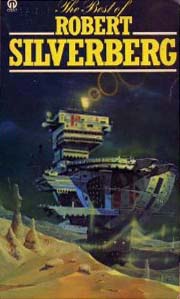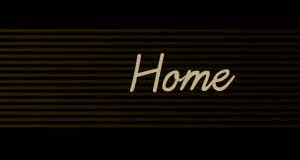|
 Hawksbill Station Hawksbill Station
 (From
the book "Solar
Wind Vol.1") (From
the book "Solar
Wind Vol.1")
 By : Deborah Susan Jones : Editor By : Deborah Susan Jones : Editor
 Painted in 1977 for the cover of the 1978
release of a Futura Publications science fiction paperback edition in
the UK titled "The best of Robert
Silverberg" it included a story titled "Hawksbill Station",
the one chosen by the artist to respond to. Painted in 1977 for the cover of the 1978
release of a Futura Publications science fiction paperback edition in
the UK titled "The best of Robert
Silverberg" it included a story titled "Hawksbill Station",
the one chosen by the artist to respond to.
 Whilst a novel length version, expanded from
the short story first published in Galaxy Science
Fiction in 1967 and then published in 1968, the shorter
version also appeared in the Futura collection and seemed to the
artist to present the opportunity to create a classic
image of that era, that of futuristic but ominous
architecture and the content of the storyline, that of a
penal colony in the pre-Cambrian era created by an
authoritarian United States government, using time
travel as a means to exile rebels and political
dissidents into the past, offered the perfect jump-off
point for the artist's imagination. Whilst a novel length version, expanded from
the short story first published in Galaxy Science
Fiction in 1967 and then published in 1968, the shorter
version also appeared in the Futura collection and seemed to the
artist to present the opportunity to create a classic
image of that era, that of futuristic but ominous
architecture and the content of the storyline, that of a
penal colony in the pre-Cambrian era created by an
authoritarian United States government, using time
travel as a means to exile rebels and political
dissidents into the past, offered the perfect jump-off
point for the artist's imagination.
  At that time, the late 1970s, a typical way
to render things like technology and mist on planets and
gas in space was with an airbrush and certainly Peter
deployed that tool many times. But in this case, as was
his ongoing focus at the time and over all the years he
painted book covers, and still to this day, he
experimented with producing the effects simply with a
standard paintbrush, using glazes of oil paint, applied
again, and again, and again, until the effect needed was
built up. At that time, the late 1970s, a typical way
to render things like technology and mist on planets and
gas in space was with an airbrush and certainly Peter
deployed that tool many times. But in this case, as was
his ongoing focus at the time and over all the years he
painted book covers, and still to this day, he
experimented with producing the effects simply with a
standard paintbrush, using glazes of oil paint, applied
again, and again, and again, until the effect needed was
built up.
 Another technical experiment carried out in
the picture was to use a paint called Plaka, which is a
casein tempera, a paint derived from milk casein;
fast-drying, water-soluble and which can be applied
thinly and repetitively to give a very flat appearance,
which is how the slab-sided presentation of the
foreground sand dunes was achieved and made distinct
from the gaseous effects on the planet, the reflections
and energy beams emitted from the building's transmitter
mast, and the clouds in the sky. Another technical experiment carried out in
the picture was to use a paint called Plaka, which is a
casein tempera, a paint derived from milk casein;
fast-drying, water-soluble and which can be applied
thinly and repetitively to give a very flat appearance,
which is how the slab-sided presentation of the
foreground sand dunes was achieved and made distinct
from the gaseous effects on the planet, the reflections
and energy beams emitted from the building's transmitter
mast, and the clouds in the sky.
 To achieve the effect of the rocky, pebbly
area of landscape in the distance, and make it distinct
from the flat-sided foreground dunes, an early form of
his "Acryoil" technique was used, whereby interleaved
layers of oil and acrylic are laid one on top of another
to achieve, in this case, a crumbly, rough appearance. To achieve the effect of the rocky, pebbly
area of landscape in the distance, and make it distinct
from the flat-sided foreground dunes, an early form of
his "Acryoil" technique was used, whereby interleaved
layers of oil and acrylic are laid one on top of another
to achieve, in this case, a crumbly, rough appearance.
 As you can see, it was a time of great
technical experimentation, carried out at his basement
studio in the lower Putney end of London's Fulham
Road which is where he was based in the late 70s. As you can see, it was a time of great
technical experimentation, carried out at his basement
studio in the lower Putney end of London's Fulham
Road which is where he was based in the late 70s.
 All this innovation and experimentation,
while sticking religiously to the code of "the deadine
is sacrosanct". All this innovation and experimentation,
while sticking religiously to the code of "the deadine
is sacrosanct".
 Imagine, if it had all gone wrong . . . . . . Imagine, if it had all gone wrong . . . . . .
 "You're only as good as your last job" (but
one, maybe). "You're only as good as your last job" (but
one, maybe).
 Read more in the book here! Read more in the book here!
 Deborah
Susan Jones Deborah
Susan Jones

|

|

 Currency
converter
Currency
converter Join
our Newsletter
Join
our Newsletter
 Deborah
Susan Jones
Deborah
Susan Jones







 Currency
converter
Currency
converter Join
our Newsletter
Join
our Newsletter
 Deborah
Susan Jones
Deborah
Susan Jones





